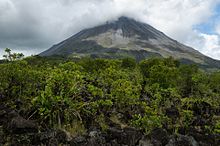Arenal Volcano
[1] The volcano was dormant for hundreds of years and exhibited 2 craters at its summit, with minor fumaroles activity, covered by dense vegetation.
[4] Arenal is one of seven historically active Costa Rican volcanoes along with Poás, Irazú, Miravalles, Orosí, Rincón de la Vieja complex, and Turrialba.
The eruptions continued unabated for several days, burying over 15 square kilometers (5.8 sq mi) under rocks, lava and ash.
When it was finally over, the eruptions had killed 87 people and buried 3 small villages – Tabacón, Pueblo Nuevo and San Luís – and affected more than 232 square kilometers (90 sq mi) of land.
[9] At the height of its ferocious activity, the volcano flung giant rocks – some weighing several tons – more than a kilometer (half a mile) away at a rate of 600 meters per second (2,000 ft/s; 1,300 mph).
"The Fortune" refers to the flat, fertile lands in the area, which are unlike the rough, mountainous terrain which surrounds most of the Arenal volcano.
At this time the volcano started to produce regular lava flows, accompanied by intermittent explosions of gases.
As a normal precaution, authorities declared a red alert, closed the road between La Fortuna and Tilarán, which runs around the north side of the volcano, and evacuated approximately 450 people (mostly tourists) from the immediate area, including several hotels and tourism-oriented businesses.
The eruptions of May 7, 1998, damaged 2 square kilometers (0.77 sq mi) and destroyed a 400-by-100-meter (1,310 by 330 ft) area of green forest in the vicinity of Arenal Volcano.
Local seismologists investigate the activity of the volcano and park rangers continue to vigorously enforce the safety perimeter.
Last eruption reported, presence of fumeroles at the summit, under Green Alert (calm status) by local authorities.


